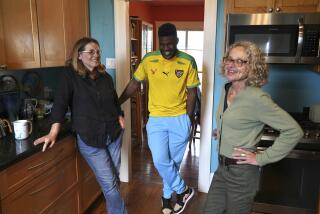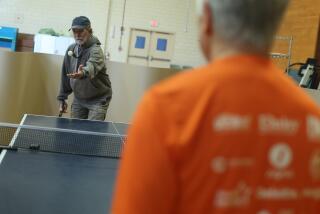Health Workers Help Ease Older Cambodians Over Cultural Barrier
Nem Norn is almost always tired. A refugee from Cambodia, Nem, 53, saw two of his children killed by the communist Khmer Rouge before he fled to the United States five years ago. Today he shares a small apartment in Long Beach with his wife and four surviving children where, suspecting that his constant state of exhaustion stems from the longstanding depression of his past, he struggles through his days with little help.
Yoth Yoeung, 45, has a lump in her throat. Once she went to a doctor, but the doctor could not speak her language. So Yoeung, also a Cambodian refugee, does the best she can without much comprehension. “I never understand what the doctor says,” she explained through an interpreter who recently visited her apartment.
That interpreter was part of a new program that already has served about 350 older Southeast Asians in Long Beach, either by luring them to health education classes or by providing translators for their appointments with doctors. Sponsored by St. Mary Medical Center and United Cambodian Community Inc., its aim is to reach Southeast Asians 45 and older, particularly Cambodian refugees, whose language barriers, cultural values, fear or general alienation often prevent them from seeking or using much-needed medical care.
“It’s an uphill battle,” said Lillian Lew, project director, “but I’m sure that we can make an impact on this community.”
In the seven months since the program began, she said, it has sent teams of bilingual health workers door-to-door in central-city apartment complexes where large numbers of Southeast Asians live. The teams also have been stationed at a local Cambodian Buddhist temple, where many older Cambodians spend much of their time.
The service is delivered in two basic ways, Lew said. First, health workers introduce themselves, distribute leaflets bearing the program’s telephone number and interview people regarding the general state of their health. And second, she said, they organize “health fairs” at the temple or in the apartment complexes to provide health education and such basic health-care screening as blood pressure checks, diabetes tests and vision exams.
When health problems are discovered, Lew said, project workers make appointments for the refugees with doctors of their choice or at St. Mary. If necessary, she said, they provide transportation to the doctor’s office and may act as interpreters during the appointments.
Eventually, Lew said, she hopes to expand the program into Asian markets, where health workers would give lectures on nutrition and provide demonstrations on healthful methods of cooking.
Diet is a key reason for the program, according to Lew, a Chinese-American who is a registered dietitian with degrees in sociology and cross-cultural education. Among other things, she said, Southeast Asian traditions encourage the consumption of fatty meats, which contributes to a high incidence of strokes and cardiovascular disease; pickled or fermented foods, which doctors suspect of causing stomach cancer, and foods high in sodium, which contribute to hypertension.
Many of the Cambodian refugees’ general health problems were made worse under the regime of Khmer Rouge guerrilla leader Pol Pot, when food was scarce, and by life in refugee camps, where conditions were primitive.
Although no data exists on the health status of Southeast Asian refugees, Lew said, they seem to suffer from high rates of hepatitis B, perhaps caused by unsanitary living conditions; malnutrition, which is probably a result of the war years, and diabetes, which may be diet or stress-related.
In addition, she said, many older Cambodians suffer from serious mental health problems, resulting both from the trauma of their past experiences and their current difficulties in adapting to a new culture.
One of the goals of the new health project, Lew said, is to collect some of the missing data on the health needs of older Southeast Asians. The task is difficult because they are wary, she said.
“The Southeast Asians have a different world health view,” Lew said. “They have their own underground health culture.”
One popular perception holds that a hospital is a place where one goes only to die. Because medical techniques in that region are an average of 30 years behind those in the United States, Lew said, many refugees utilize herbal cures, spiritual healing or over-the-counter medicines rather than seek the advice of trained physicians.
It was to help provide alternatives to those practices that the FHP Foundation--a Long Beach-based organization dedicated to supporting health-care education, research and services--recently awarded a $140,000 grant to the Southeast Asian Health Project, which runs the new program. The money is being used, Lew said, for printed materials, health fair personnel and to pay the salaries of the teams of bilingual health workers.
Most of the refugees encountered during a recent visit to their apartment complex seemed to appreciate the personal attention.
“I’m very happy if someone comes to knock at my door,” said Lach Kheng, 57, who, speaking through the interpreter, had complained of “hot” feeings inside his stomach. “It’s a help. I don’t know where to go or what to do. At least now I can discuss it.”
More to Read
Sign up for Essential California
The most important California stories and recommendations in your inbox every morning.
You may occasionally receive promotional content from the Los Angeles Times.









